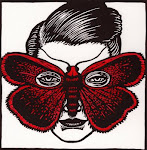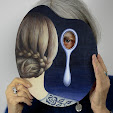Above: Australian Book Arts Journal (front cover)
Click on image to enlarge
Click on image to enlarge
Excerpt from Metamorphosis (1) Click on image to enlarge
Metamorphosis (excerpt 2) Click on image to enlarge
The article, printed in its entirety directly below, appears in the current issue of Australian Book Arts Journal.
METAMORPHOSIS by Deborah Klein
For several years I have been researching fairy tales and folk tales. Although my fascination with the tradition of woodland myth and allegory dates from childhood, it has lately become the primary focus of my work, beginning with the Moth Women, a suite of small-scale paintings of women whose faces are partly concealed by elaborate moth-like masks. They were originally created for the 2008-2009 touring exhibition The enchanted forest – new gothic storytellers. But these mysterious women proved to have lives of their own beyond the Enchanted Forest. More Moth Women subsequently appeared, some as drawings, others as linocuts. Selections of the prints were subsequently gathered together in the artist’s book Women with Wings (2010).
My cast of characters was further expanded to include a cluster of eight women, their intricately woven coiffures held precariously in check by a series of jewel-like hair ornaments resembling disconcertingly life-like bugs and arthropods (including a red back spider, a dragonfly and a cicada.) Soon another group of exotic hybrid creatures joined them: a swarm of eighteen airborne women, each with her own unique set of intricately patterned butterfly wings.
As my personal mythology developed, I began to write some fairy tales of my own. The first of these, The Story of the Moth Masks, The Enchanted Hair Ornaments and Swarm, took the works described above as points of departure. My intention was to use the texts as the basis for three limited edition artist’s books illustrated with relief prints. For 18 months I worked on linocuts for all three books.
But in the meantime, further tales began to emerge, which led me to put the projects on temporary hold. They were not only independent of the new work, but also of the insect iconography that underpinned it. Several of these stories, including The Girl in the Tower and Moth Eaten, were contemporary takes on traditional fairy tales.
Thirteen stories had now accumulated, and I decided to compile them in the format of a zine, which I felt I could construct with comparative simplicity. Searching through my back catalogue of works for images that might fit the stories, I found a surprising number (including the painting The Long, Long Braid that was eventually paired with the story The Girl in the Tower) were close to ideal matches. Before too long I was set to present these in the photocopied and saddle stitched (i.e. stapled) format that is characteristic of the humble zine. It was then that my friend Doug Willis asked me to email him my efforts. He said he “thought I could do better”. Together with Doug’s inestimable layout and computer skills and some constructive criticism, came his suggestion that I turn my efforts into the book that became There was once…The collected fairy tales. A local printer recommended by Doug gave me an excellent quote. My intention was to produce a limited edition of 500 copies, but I was advised that a larger edition – in this case 1000 - would be more economical.
A number of books were essential references, among them From the Beast to the Blonde by Marina Warner, a history of fairy tales and their tellers. Equally important were the novels and short stories of Angela Carter, including The Magic Toyshop, and The Bloody Chamber and Other Stories, the latter an anthology of ten fairy tales, told with dark, wicked humour and incisive feminist twists - particularly the title story. A companion piece to these was the Virago Book of Fairy Tales, edited by Carter.
Fairy tales can teach us to make sense of our world, and some of my stories were an attempt to make sense of mine. I learned as much from Hans Christian Andersen’s life as I did from reading his works. He created tales that were completely original, rather than based on folk tales, such as those of the Brothers Grimm (many of which were sourced from women, most of them never credited.) A significant number of Christian Andersen’s stories are autobiographical - for example, The Ugly Duckling. Yet despite their intensely personal nature, they have the same mythic power as ancient folk tales. The biography Hans Christian Andersen - The Life of a Storyteller by Jackie Wullschlager also maintains that his stories have frequently been ill served by English translators, their fine intelligence, pathos and wit too often replaced by cloying sentimentality.
Although my intention to turn my fairy tales into a zine was suspended for the greater good of the project, the lure of zines has proved irresistible. I have since made two of them and plan to do more. My first zine A Short Book about Long Hair and the recently released Material Girls gave older imagery new life, enabling me to present it in a completely different context. Hair remains an enduring emblem. The former zine pairs rear views of women displaying elaborate hairstyles with hair quotations (the one by Raymond Chandler is a personal favourite.) The latter zine combines imagery featuring women’s sewing iconography with related literary and historical texts. Despite aiming for an aesthetic that has more in common with artist’s books, I am drawn to the low-tech, hand made nature of zines, including typing the texts on my Brother manual typewriter, purchased last year for that very purpose.
As a visual artist with metamorphosis at the core of my work, its unforeseen evolution from image to text to book seems uncannily appropriate. One of the most abiding lessons I have learned is that making books – including zines - takes a great deal of time, especially if you want the end result to be as fine as you can possibly make it. My book projects will continue into 2011. In fact I have already set aside next year to focus on artist’s books, and can hardly wait.
From Australian Book Arts Journal, issue 3, TEXT as image, IMAGE as Text, December 2010, published by Linda Douglas, Brisbane, Queensland.




















